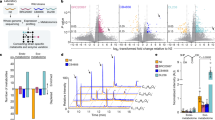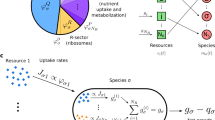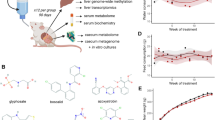Abstract
Many populations show density-dependent growth rates. We suggest that population growth rate may be connected to density through the density dependence of metabolic rate. If metabolic rate is an index of the total biochemical work being done by an organism, then as populations grow and density suppresses metabolic rate, the rate of reproduction should slow and the ability to avoid death should diminish. To test this idea, we grew axenic populations of a single-celled protist, Tetrahymena pyriformis, in laboratory microcosms, and measured metabolic rate and density. We also estimated division (birth) and death rates. The proposed connection was supported by two observations. First, increasing population density suppressed per-capita metabolic rate in accordance with the predictions of a resource-division model. The same pattern was shown with experimentally altered densities. Second, per-capita metabolic rate was positively related to per-capita division rate and negatively related to per-capita death rate. Thus, the particular pattern of population growth and regulation depends on exactly how individuals respond energetically to the density of conspecifics, and how they allocate metabolism to maintenance and production. The physiological basis of population regulation in this system is based on the constraints imposed on the total metabolic work that individual cells can perform.
Similar content being viewed by others
Log in or create a free account to read this content
Gain free access to this article, as well as selected content from this journal and more on nature.com
or
References
Atkinson D, Ciotti BJ, Montagnes DJS . (2003). Protists decrease in size linearly with temperature: ca 2.5% °C−1. Proc Roy Soc Lond B 270: 2605–2611.
Berryman AA, Arce ML, Hawkins BA . (2002). Population regulation, emergent properties, and a requiem for density dependence. Oikos 99: 600–606.
Brown JH, Gillooly JF, Allen AP, Savage VM, West GB . (2004). Toward a metabolic theory of ecology. Ecology 85: 1771–1789.
Brown JH, Sibly RM . (2006). Life-history evolution under a production constraint. Proc Natl Acad Sci USA 103: 17595–17599.
Bulmer MG . (1975). The statistical analysis of density dependence. Biom 31: 901–911.
Cameron IL, Jeter JR . (1970). Synchronization of the cell cycle of Tetrahymena by starvation and refeeding. J Protoz 17: 429–433.
DeLong JP, Hanson DT . (2009). Density-dependent individual and population-level metabolic rates in a suite of single-celled eukaryotes. Open Biol J 2: 32–37.
Fenchel T, Finlay BJ . (1983). Respiration rates in heterotrophic, free-living protozoa. Microb Ecol 9: 99–122.
Forrester GE, Evans B, Steele MA, Vance RR . (2006). Assessing the magnitude of intra- and interspecific competition in two coral reef fishes. Oecologia 148: 632–640.
Gause GF . (1934). The Struggle For Existence. Williams and Wilkins: Baltimore, (Reprinted 1964 by Hafner).
Gillooly JF, Brown JH, West GB, Savage VM, Charnov EL . (2001). Effects of size and temperature on metabolic rate. Science 293: 2248–2251.
Hixon MA, Carr MH . (1997). Synergistic predation, density dependence, and population regulation in marine fish. Science 277: 946–949.
Lambers JHR, Clark JS, Beckage B . (2002). Density-dependent mortality and the latitudinal gradient in species diversity. Nature 417: 732–735.
Lewis S, Sherratt TN, Hamer KC, Wanless S . (2001). Evidence of intra-specific competition for food in a pelagic seabird. Nature 412: 816–819.
Lynn DH . (2008). The Ciliated Protozoa: Characterization, Classification, and Guide to the Literature, 3rd edn. Springer: Berlin, Germany.
Nässberger L, Monti M . (1984). Assessment of overall metabolism in Amoeba proteus measured by a microcalorimetric method. Protoplasma 123: 135–139.
Ohman MD, Hirche H-J . (2001). Density-dependent mortality in an oceanic copepod population. Nature 412: 638–641.
Pace DM, Kimura TE . (1944). The effect of temperature on respiration in Paramecium aurelia and Paramecium caudatum. J Cell Comp Phys 24: 173–183.
Pearl R . (1927). The growth of populations. Q Rev Biol 2: 532–548.
Schmoker C, Hernandez-Leon S . (2003). The effect of food on the respiration rates of Daphnia magna using a flow-through system. Scientia Marina 67: 361–365.
Secor SM, Diamond J . (1998). A vertebrate model of extreme physiological regulation. Nature 395: 659–662.
Sibly R, Barker D, Denham MC, Hone J, Pagel M . (2005). On the regulation of populations of mammals, birds, fish, and insects. Science 309: 607–610.
Tonn WN, Holopainen IJ, Paszkowski CA . (1994). Density-dependent effects and the regulation of Crucian carp populations in single-species ponds. Ecol 75: 824–834.
Turchin P . (1999). Population regulation: a synthetic view. Oikos 84: 153–159.
van Aarde R, Whyte I, Pimm S . (1999). Culling and the dynamics of the Kruger National Park African elephant population. Anim Cons 2: 287–294.
Woiwod IP, Hanski I . (1992). Patterns of density dependence in moths and aphids. J Anim Ecol 61: 619–629.
Acknowledgements
We appreciate the input of J Brown, O Burger, L Marschall, T Meehan, R Sibly, P Turchin and several anonymous reviewers. The programming assistance from E Toolson was indispensable. We also greatly appreciate the laboratory assistance of U Bergthorsson and his laboratory members. Funds for this work came from UNM GRAC, SRAC, and a Grove Summer Scholarship to JPD. Funding was also provided by UNM research allocation committee Grant #05-L-07 to DTH.
Author information
Authors and Affiliations
Corresponding author
Rights and permissions
About this article
Cite this article
DeLong, J., Hanson, D. Metabolic rate links density to demography in Tetrahymena pyriformis. ISME J 3, 1396–1401 (2009). https://doi.org/10.1038/ismej.2009.81
Received:
Revised:
Accepted:
Published:
Issue date:
DOI: https://doi.org/10.1038/ismej.2009.81
Keywords
This article is cited by
-
On-line stable isotope gas exchange reveals an inducible but leaky carbon concentrating mechanism in Nannochloropsis salina
Photosynthesis Research (2014)



